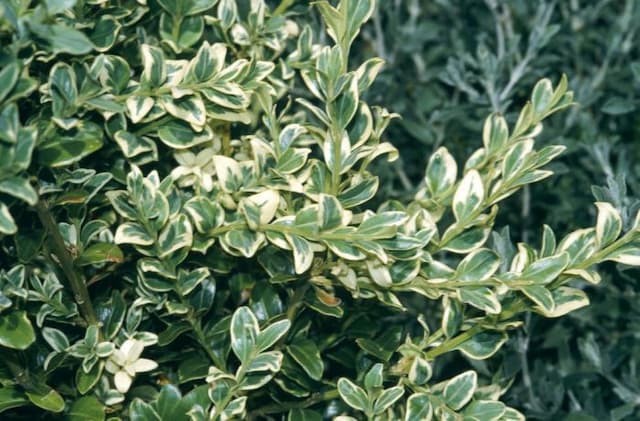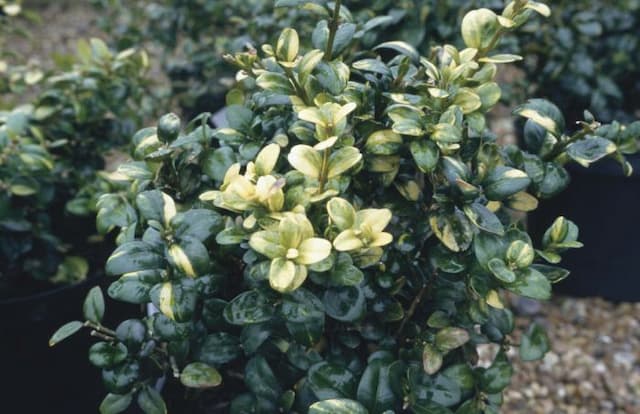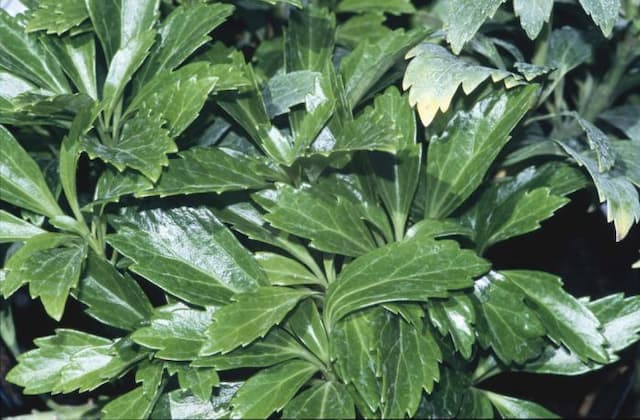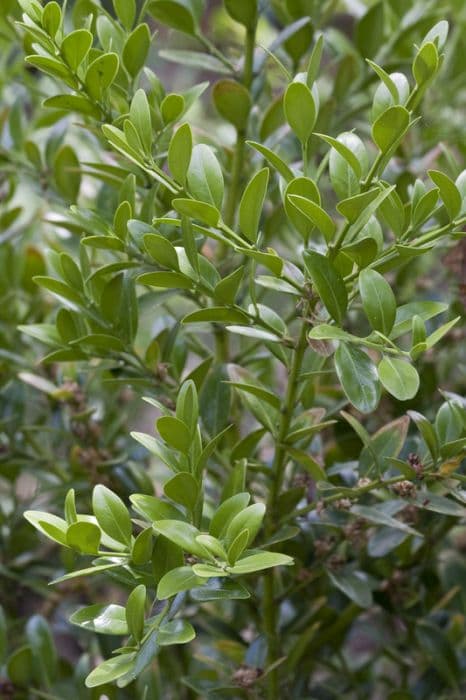Japanese Boxwood Buxus microphylla 'Faulkner'

ABOUT
The plant known as Littleleaf Boxwood displays a dense, rounded and compact shape, which gives it a neat and manicured appearance. It's characterized by its lustrous, small, glossy, light green leaves that maintain their color throughout the year, offering a constant show of vibrancy in the landscape. The leaves are oval-shaped and arranged oppositely on the stems, creating a fine texture that adds an elegant touch to the plant's overall aesthetics. During spring, Littleleaf Boxwood may produce inconspicuous flowers, which are often not a significant part of its visual appeal. Instead, it's the plant's foliage and form that take center stage, making it a favorite for hedges and topiaries. Overall, the plant exudes a sense of order and tradition, often associated with formal garden designs.
About this plant
 Names
NamesFamily
Buxaceae
Synonyms
Littleleaf Boxwood, Japanese Boxwood, Faulkner Boxwood
Common names
Buxus microphylla 'Faulkner'.
 Toxicity
ToxicityTo humans
The plant commonly known as boxwood is considered toxic to humans. If ingested, any part of the plant can cause symptoms of toxicity. Common symptoms from poisoning include gastrointestinal upset such as nausea, vomiting, and diarrhea. In severe cases, boxwood ingestion can lead to dizziness, seizures, and respiratory failure. The symptoms are due to the presence of alkaloids such as buxine, which can affect the nervous system, and other compounds that are irritants.
To pets
Boxwood is also toxic to pets, including dogs and cats. The ingestion of any part of the boxwood plant can result in poisoning. Symptoms that a pet may display after ingestion include vomiting, diarrhea, and possibly hyper-salivation. More severe toxicity can lead to symptoms like weakness, seizures, and respiratory problems. As with humans, the toxicity can be attributed to the alkaloid buxine and other harmful compounds within the plant. Pet owners should ensure that animals don’t have access to boxwood and should contact a veterinarian immediately if they suspect their pet has ingested any part of the plant.
 Characteristics
CharacteristicsLife cycle
Perennials
Foliage type
Evergreen
Color of leaves
Green
Height
2 feet 5 inches (0.74 meters)
Spread
2 feet 5 inches (0.74 meters)
Plant type
Shrub
Hardiness zones
6
Native area
Japan
Benefits
 General Benefits
General Benefits- Ornamental Appeal: Buxus microphylla 'Faulkner', commonly known as Littleleaf Boxwood, has a compact and dense growth habit that makes it excellent for ornamental use in landscaping.
- Low Maintenance: Littleleaf Boxwood is relatively easy to care for, requiring minimal pruning to maintain its shape and size.
- Drought Tolerance: Once established, it is quite tolerant to drought, making it suitable for gardens in drier climates or for gardeners seeking plants with lower water requirements.
- Pest Resistance: The Littleleaf Boxwood is resistant to many pests, reducing the need for chemical treatments in the garden.
- Year-Round Interest: With its evergreen foliage, Littleleaf Boxwood provides year-round color and interest in the garden.
- Versatility: It can be used in a variety of landscaping applications, including hedges, topiaries, and as a specimen plant.
- Soil Adaptability: Littleleaf Boxwood can adapt to a wide range of soil conditions, although it prefers well-drained soils with a slightly acidic to neutral pH.
- Cold Hardiness: It has good cold tolerance, making it a suitable choice for colder climates.
- Edge Definition: Its fine texture and ability to be shaped make Littleleaf Boxwood ideal for defining edges and borders in gardens and pathways.
- Privacy Screening: When planted in rows or groups, Littleleaf Boxwood can provide an effective privacy screen or windbreak.
 Medical Properties
Medical PropertiesThis plant is not used for medical purposes.
 Air-purifying Qualities
Air-purifying QualitiesThis plant is not specifically known for air purifying qualities.
 Other Uses
Other Uses- Artistic Topiary: Buxus microphylla 'Faulkner' or Japanese boxwood is widely used for topiary art because of its dense foliage and ability to tolerate regular pruning, allowing gardeners to sculpt it into various artistic shapes and forms.
- Miniature Gardens: Japanese boxwood, with its small leaves and compact growth, makes an excellent choice for creating fairy gardens or miniature landscapes, providing a sense of scale and lush greenery.
- Garden Borders: This plant is often used to define the boundaries of different sections in a garden, serving as a low hedge that maintains clear lines and adds structure to garden design.
- Mazes and Labyrinths: Due to their ability to be shaped precisely, Japanese boxwoods are great for creating intricate maze designs and garden labyrinths that can be both decorative and interactive for visitors.
- Bonsai: Japanese boxwood can be trained as bonsai, allowing enthusiasts to enjoy the art of bonsai with a plant that adapts well to the rigorous training and shaping required for bonsai culture.
- Film and Theater Sets: When a scene requires a manicured garden look, Japanese boxwood can be used to quickly create the appearance of well-kept hedges or garden accents on stage or in movie sets.
- Religious and Cultural Symbolism: In some cultures, boxwood is used during certain festivals or religious ceremonies, symbolizing various aspects like immortality or prosperity.
- Natural Dye: The leaves of the Japanese boxwood can be used to produce a natural dye, which is a sustainable alternative to synthetic dyes for coloring fabrics or artworks.
- Garden Railroad: Model train enthusiasts sometimes use Japanese boxwood in garden railroading to create realistic miniature landscapes through which their trains can travel.
- Erosion Control: Due to its dense root system, Japanese boxwood can be planted on slopes or areas prone to erosion to help stabilize the soil and prevent loss from wind or water run-off.
Interesting Facts
 Feng Shui
Feng ShuiThe Boxwood is not used in Feng Shui practice.
 Zodiac Sign Compitability
Zodiac Sign CompitabilityThe Boxwood is not used in astrology practice.
 Plant Symbolism
Plant Symbolism- Eternity: Buxus microphylla 'Faulkner', commonly known as the Japanese Boxwood, often symbolizes eternity because of its evergreen nature, retaining its leaves throughout the year, which conveys a sense of perpetual life.
- Stability: The robust and hardy characteristics of Japanese Boxwood reflect stability and reliability, which can be associated with its usage in garden borders and hedges that last for many years.
- Fidelity: Due to its evergreen leaves, the Japanese Boxwood is also associated with fidelity, representing unwavering commitment in relationships, much like the plant's consistent appearance.
- Prosperity: In some cultures, the Japanese Boxwood is seen as a symbol of prosperity, its lush, dense foliage evoking abundance and wealth.
 Water
WaterWater Japanese boxwoods deeply when the top 1 to 2 inches of soil feels dry to the touch, which typically means watering once or twice a week during active growth periods and less often during cooler months. It's important to avoid over-watering to prevent root rot. Approximately 1 gallon of water per plant should suffice for smaller shrubs, while larger shrubs may need 2 to 3 gallons every time you water. During hot, dry spells, more frequent watering may be necessary. Always water at the base of the plant to keep the foliage dry and prevent fungal diseases.
 Light
LightJapanese boxwoods thrive best in partial sun to partial shade, which means they should be placed in a location that receives dappled sunlight or morning sun and afternoon shade. Avoid full, intense afternoon sun, especially in hotter climates, to prevent leaf scorch. An eastern or northern exposure generally provides the ideal light conditions.
 Temperature
TemperatureJapanese boxwoods can tolerate a wide range of temperatures, but they perform best in environments where the temperature is between 60°F and 70°F. They can survive temperatures as low as 0°F but may suffer from winter burn if exposed to harsh, cold winds. It's ideal to protect them from extreme winter temperatures with mulch or burlap wraps.
 Pruning
PruningPrune Japanese boxwoods to maintain their shape and dense foliage and to remove damaged or diseased branches, ideally in late winter or early spring before the onset of new growth. Thinning out the interior branches every few years helps to increase air circulation, which can reduce the risk of disease. Pruning can be done more frequently if the boxwood is being shaped for topiary or formal hedges.
 Cleaning
CleaningAs needed
 Soil
SoilThe Japanese Boxwood 'Faulkner' thrives in well-draining soil with a mix of two parts loam, one part peat moss, and one part perlite or sand, which helps with aeration and prevents root rot. The ideal soil pH for this plant is slightly acidic to neutral, ranging from 6.0 to 7.0.
 Repotting
RepottingThe Japanese Boxwood 'Faulkner' should be repotted every two to three years to prevent it from becoming root-bound and to replenish its soil with nutrients. Larger specimens may be repotted less frequently, depending on their growth rate and the size of the container.
 Humidity & Misting
Humidity & MistingThe Japanese Boxwood 'Faulkner' prefers moderate humidity but is quite adaptable to a range of conditions. It benefits from being placed in an environment with humidity levels between 40-60%, which can help maintain the health and vitality of the leaves.
 Suitable locations
Suitable locationsIndoor
Provide bright, indirect light and moderate watering for indoor Japanese Boxwood.
Outdoor
Outdoor Japanese Boxwood needs sunlight, well-draining soil, and regular pruning.
Hardiness zone
6-9 USDA
 Life cycle
Life cycleBuxus microphylla 'Faulkner', commonly known as Faulkner Boxwood, begins its life cycle when the seeds germinate in suitable environmental conditions; it requires well-drained soil and partial to full sun. After germination, it enters a juvenile phase where the shrub starts to form its dense, compact shape, with tiny, glossy, evergreen leaves. As the plant matures, it undergoes a period of vegetative growth where it increases in size and may be shaped through pruning to maintain its desired ornamental form. The Faulkner Boxwood reaches reproductive maturity and develops inconspicuous yellow-green flowers in spring, which are followed by small, inconspicuous fruits if pollinators are present. Once it reaches maturity, the plant has a slow growth rate but can live for many years with proper care, including annual pruning to avoid becoming leggy and to promote bushier growth. Throughout its lifetime, the Faulkner Boxwood may experience cycles of growth and dormancy, particularly in regions with distinct seasons, where it may become less active in growth during the colder months.
 Propogation
PropogationPropogation time
Spring-Early Summer
The Buxus microphylla 'Faulkner', commonly known as the Faulkner Boxwood, is most effectively propagated by semi-hardwood cuttings. This technique is typically done in the late summer when the new growth has matured and the stems are somewhat firm yet still flexible. A cutting, about 4 to 6 inches (approximately 10 to 15 centimeters) in length, should be taken from a healthy parent plant. The lower leaves are removed, and the cut end can be dipped in rooting hormone to encourage root development. The cutting is then planted in a well-draining potting mix, ensuring that the leaf nodes are buried as these are the points from which roots will grow. The cutting should be kept moist and in a warm environment with indirect sunlight until roots have established, which typically takes a few weeks. Once rooted, it can be transplanted to a more permanent location.









